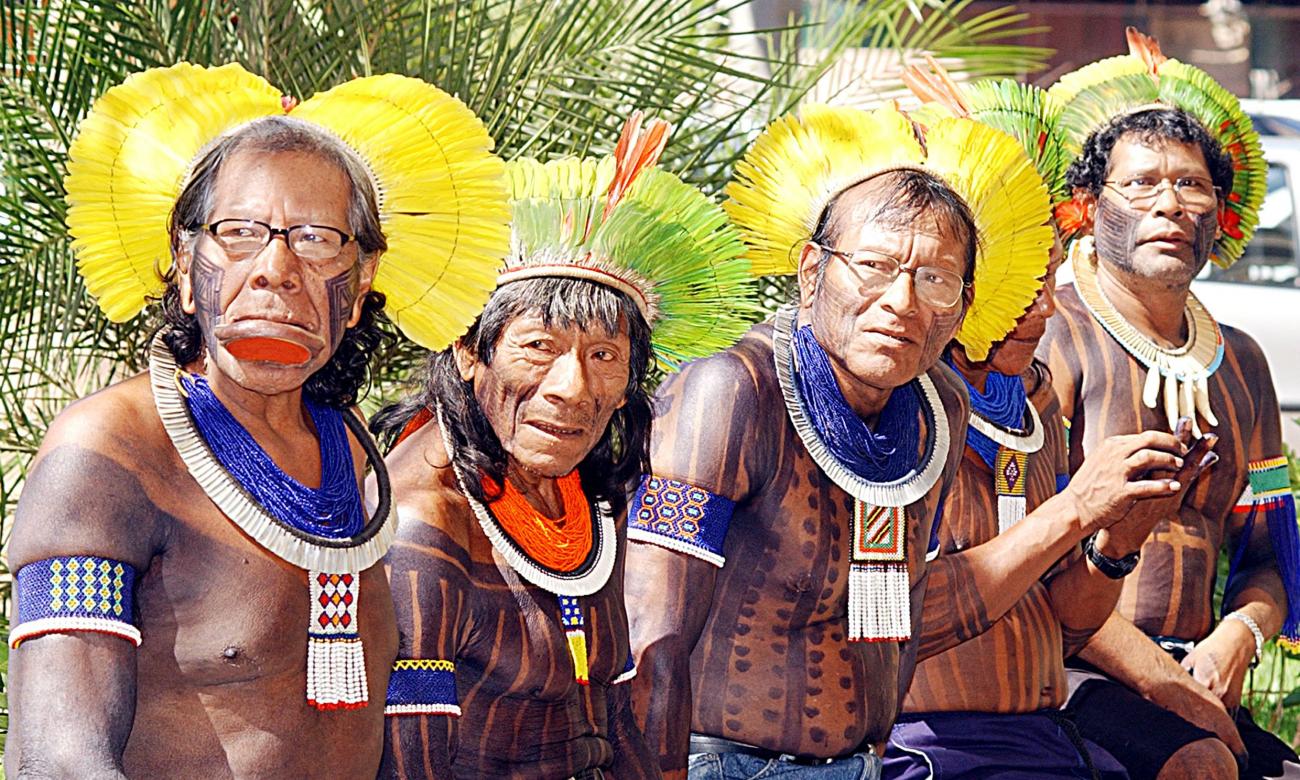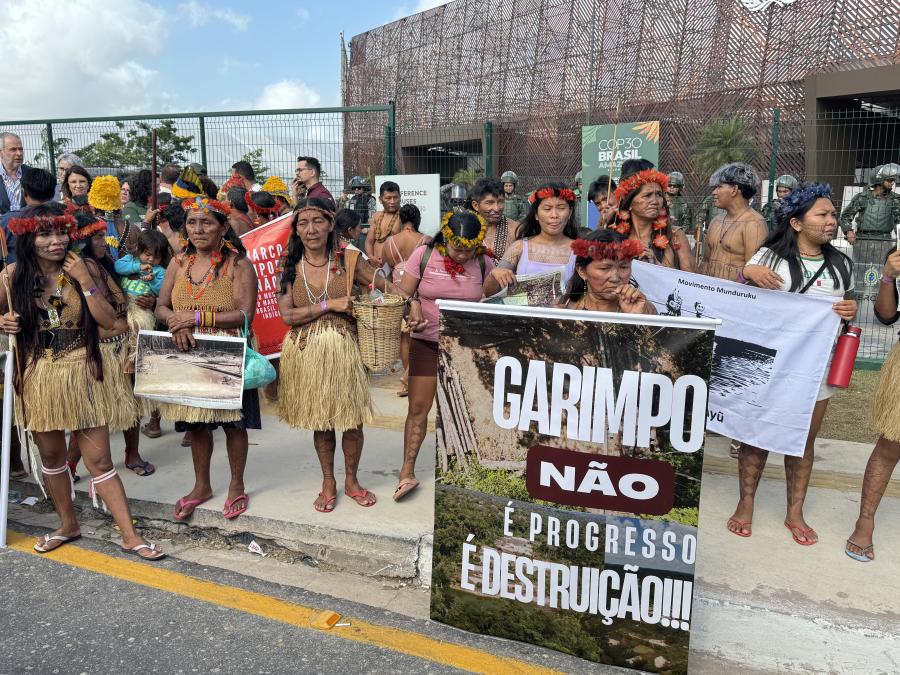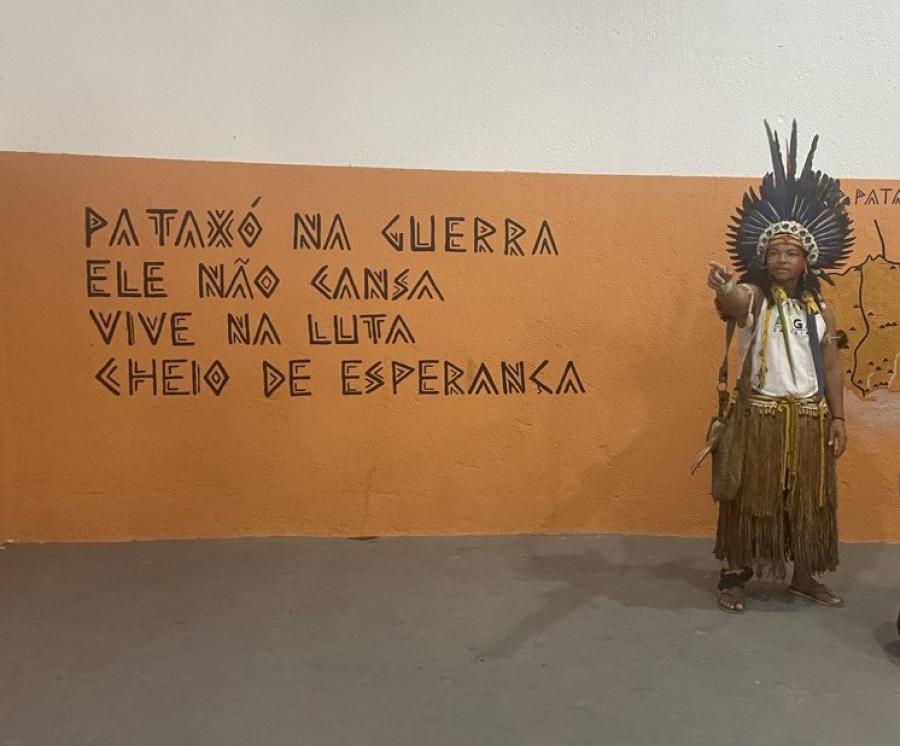
Carbondale, Illinois, USA,
18 February 2015
Dilma Rousseff
Presidente da República Federativa do Brasil
Gabinete do Presidente
Palácio do Planalto Praça dos Três Poderes
Brasília – Distrito Federal 70150-900 Brazil
Dear Madame President:
We, members of the Society for the Anthropology of Lowland South America (SALSA), an international professional association of anthropologists specializing in lowland regions of South America, write this letter to denounce the Brazilian state’s systemic disregard of the rights and well-being of indigenous peoples. We outline below some of the most egregious breaches of indigenous and human rights, noting that these represent only a small portion of the many affronts indigenous peoples of Brazil now face. We address legal, economic, infrastructural, and territorial threats. Our examples are gathered from documented reports on events occurring among the Munduruku, Guarani, Xavante and Yanomami. In particular, we condemn the Proposed Constitutional Amendment 215 (PEC-215), a recent legislative proposal threatening the demarcation of indigenous lands, and several infrastructure projects, including the Belo Monte hydroelectric project that is already before the Inter-American Court of Human Rights. We strongly urge you and Brazilian authorities to immediately correct the systemic disregard of Brazil’s indigenous citizens and wish to impress upon you the ethical and legal urgency of doing so.
Background
Native peoples in Brazil are recognized in the national constitution as the original occupants of territory in the Union, residing in 654 demarcated and registered indigenous territories (Terras Indígenas). These lands amount to about one million square kilometers, constituting 12% of the national territory. Rights to indigenous lands in Brazil are guaranteed by the Brazilian Constitution of 1988, Section 231, which confers exclusive inalienable usufruct rights to indigenous peoples on the basis of nontransferable, “original” rights. Moreover, the rights of indigenous peoples are guaranteed by international documents to which Brazil is signatory. These include The Convention 2 on Indigenous and Tribal Peoples (ILO 169/1989) and the UN Declaration on the Rights of Indigenous Peoples (UNDRIP, 2007). Brazilian law stipulates that, as titular owner of indigenous lands, the nation-state must protect these territories. A federal Indian affairs agency, the National Indian Foundation (FUNAI), is charged with securing these lands on behalf of the indigenous inhabitants, and may call for legal or juridical enforcements if federally-protected rights are violated. With the recent withdrawal of federal funding, assistance, and resources for oversight in indigenous areas, we have observed an increase in both egregious and quotidian violations of indigenous lands and persons. When enforced, the legal protections afforded indigenous territories provide a level of “excludability” not found in other forms of protected areas, such as extractive reserves or national forests. As a result, indigenous citizens have historically played a significant role in preserving Amazonia’s biodiversity in contexts of relentless pressure from mining, logging, ranching, and export agriculture. Numerous studies show that indigenous territories are more effective than other protected area types in maintaining standing forests and sequestering carbon. According to a 2007 study (Saatchi et al. 2007), biomass on indigenous lands accounts for 30% of total carbon stocked in the Brazilian Amazon (47 PgC). In the context of Brazil’s promised contribution to lower global greenhouse gas emissions (INDCs), made to the United Nations Conference on Climate Change in Paris in December 2015, the key role played by indigenous peoples in protecting forests, water, biodiversity and climate has become increasingly critical.
Concerns: Threats to Indigenous Peoples
1. PEC-215. An immediate threat to the integrity of indigenous lands, Proposed Constitutional Amendment (PEC) 215/2000, which must yet pass through several stages of approval, would prohibit the future expansion of demarcated indigenous territories and provide for the indemnization of land-owners who have unlawfully entered demarcated indigenous areas. It would transfer the power to register all protected areas, including indigenous and quilombola lands as well as environmentally protected areas, from the executive branch to National Congress. The proposal, sponsored by the bancada ruralista, an informal bloc made up of representatives who defend agribusiness, would modify the constitution to benefit agribusiness and other commercial activities such as mining, at the expense of traditional inhabitants, without honoring their constitutional rights to these territories. If it were to pass, this proposed amendment would effectively end the process of demarcating indigenous lands -- a major concern, as an estimated 225 (45%) indigenous territories have not yet been demarcated. Many pending cases are stalled and are yet to be resolved. For example, residents of more than 50 indigenous areas in Mato Grosso do Sul have long awaited demarcation, and face lethal conflict in this regard. Among them are the Guarani-Kaiowá, who over 500 years were repeatedly displaced from their traditional lands to make way for nonindigenous settlers, and are currently experiencing untoward pressure from large-scale ranchers and farmers to vacate their properties. Among the Xavante, claims in Sangradouro, Areões, Etarãirebere, Norotsurã, Isou'pa, and Hu’hi have been suspended since 2006, as a result of interventions from the Governor of Mato Grosso state and the 3 Ministry of Justice. T.I Wedezé, which was delimited on December 26, 2011 in Depacho no. 676/PRES/2011, is the most recent case. The proposed law severely constrains indigenous rights to their lands and resources, countering guarantees to these in the Constitution of Brazil, the UNDRIP, and ILO 169.
2. Assassinations and suicides.
Breaches against the human rights of the Guarani-Kaiowá are recognized as among the worst in the Americas by the United Nations and the Indigenous Missionary Council of Brazil (CIMI). A pattern of longstanding conflict and violence between indigenous communities and agribusinesses has led to the killing of over 390 Guarani and Kaiowá individuals since 2003 (UN 2015). CIMI cites no less than 138 murders for the year 2014 alone. Moreover, the suicide rate among the Guarani is one of the highest in the world. Between the years 2000 and 2014, approximately 707 Guarani have committed suicide, exceeding 2% of the total Guarani population and twenty times the national rate. Currently, in the Guarani village of Dourados, the data show one homicide every twelve days and one suicide every seven days. Guarani children as young as nine years old have taken their own lives. With a population of 45,000, the Guarani-Kaiowá are one of the largest indigenous populations of Brazil. Yet the population occupies only 30 hectares of their traditional territory. (By comparison, Mato Grosso do Sul’s 23 million cattle occupy 23 million hectares of land.) According to data from the federal government, if all the areas claimed by the Guarani-Kaiowá as indigenous territories were to be demarcated they would represent merely 2% of Mato Grosso do Sul’s total area. In a context of land shortages, in July and August of this year, federal courts demanded the eviction of over 6,000 Guarani. In response, and pursuant to a Guarani complaint brought to her office, the United Nations Special Rapporteur on the Rights of Indigenous People, Victoria Tauli-Corpuz, urged the Government of Brazil “to ensure that the human rights of the Guarani and Kaiowá indigenous people are fully respected, in strict compliance with international standards protecting the rights of indigenous peoples” (UN 2015).
3. Preventable and treatable diseases.
Assassinations and suicides dramatically represent the critical situation of indigenous health in Brazil. Less visible, but equally devastating, are preventable and treatable diseases. Xavante people, for example, are suffering a serious and inexcusable health crisis. Xavante infant mortality is exceedingly high. In 2014, one Xavante child died every three days. This number represents 15% of the total infant deaths in all Brazil. In 2014, no other ethnic group in Brazil suffered such high morbidity among children under the age of 5. Preventable diseases are the principle cause of death. Xavante are also suffering a diabetes epidemic with rates far above the national average. In the Indigenous Territories of Sangradouro and São Marcos, 28.2% of the population is diabetic. Xavante suffer the disease more than 3 times the national rate of 7.6%. This epidemic is the direct result of radical transformations in the diet and lifestyle caused by sedentization, environmental destruction, and state policies that, beginning in the 1970s, mandated industrial rice cultivation in Xavante areas.
4. Invasions and violence.
Federal agencies are not only remiss in protecting indigenous lands, they are openly putting indigenous lives at risk. With the absence of federal oversight, invasions into indigenous lands by renegade loggers and miners have prompted violent responses involving indigenous peoples and state agencies. Recently, in the states of Maranhão and Pará, indigenous peoples have been drawn into violence by the combined increase in illegal logging on indigenous land, the withdrawal of federal resources for FUNAI, and the informal provisions of arms or ammunition by various agents, including government representatives. In one case, a Ka'apor leader, Eusébio Ka’apor was murdered after opposing illegal logging. Government agencies, including the Federal Police as well as FUNAI, must be counted upon to carry out their federallymandated function of protecting indigenous peoples and lands, rather than placing them in danger. In cases like these, where local and state agencies fail to protect indigenous people and lands and uphold the law, the federal government must step in. The purpose of government presence in indigenous lands is to protect, not endanger, the inhabitants.
5. Threats to isolated groups.
Invasions into remote indigenous territories by miners and loggers occur with impunity. In September of 2015, the Hutukara indigenous association reported the invasion of wildcat miners into Yanomami lands, announcing, “The [federally-demarcated] Yanomami indigenous territory is overrun with illegal gold miners. There are more of them each day, and they are ruining the forest, polluting the rivers… and causing irreparable damage to our health and culture.” Along with the Indigenous Missionary Council (CIMI) and the Diocese of Roraima, Hutukara reported that the prospectors had invaded a portion of the territory occupied by the isolated sub-group known as Moxi Hatëtëa. The threat of prospectors in the vicinity of relatively uncontacted, vulnerable populations, is a serious concern. In what became known as the “Massacre of Haximu” in the late 1980s and early 1990s, illegal miners in the same territory caused the deaths of approximately two thousand Yanomami. Besides bringing contagious diseases for which the isolated groups may have no immunity, the illegal activities of the miners also result in damages to the forest and rivers, causing irreparable harm to the region and to the health and culture of the Yanomami. The newest incursion occurred at a site where a FUNAI post had recently been closed due to lack of resources. If FUNAI is to abandon its role of territorial protections, there must be an adequate replacement; dereliction by protective entities could prove fatal.
6. Infrastructure Projects and Lack of Adequate Consultation.
A number of state infrastructure projects encroach upon indigenous lands. These projects proceed in open violation of Articles 231 and 232 of Brazil’s Constitution, and the international charters ILO 169 and UNDRIP, all of which guarantee indigenous and traditional inhabitants the right to consultation regarding infrastructure projects. For example, the Brazilian government has plans to build more than 60 large dams in the Amazon Basin over the next 20 years, and also has plans for numerous small hydroelectric dams. In the Tapajós Valley of Pará state, the traditional territory of the Munduruku will be directly affected by the construction of seven hydroelectric plants. If built, the Tapajós Hydroelectric Complex would partially flood the traditional territory, 5 inundating several villages, productive lands, and sacred sites utilized by hundreds of Munduruku families. The Munduruku say that they were not consulted, as is guaranteed them by ILO 169 and UNDRIP. They accuse the government of breaking an agreement with the Munduruku assuring them “free, prior, and informed consent” be gained before any dam project can proceed (ISA 2015). Furthermore, FUNAI recommended in September 2013 that Munduruku lands be demarcated as an indigenous reserve, a process that was halted, due in part to conflicts stemming from the Ministry of Mines and Energy. The area that will be affected by the hydroelectric projects also includes two national forests (FLONA Itaituba I and II), under the supervision of the federal environmental agency, Instituto Chico Mendes. In an unprecedented act, the federal government sent military troops into the region in 2013 to accompany analysts conducting environmental impact studies, a prerequisite to auctioning construction bids for the dam projects. This action not only violates the human rights of the Munduruku people, but demonstrates that the federal government is willing to use military force to protect the interests of elites rather than enforce the rights of indigenous peoples. The Belo Monte Dam, currently under construction on the Xingu River, one of the Amazon’s few clearwater tributaries, would be the world’s third-largest hydroelectric project. It would divert the flow of the Xingu, displacing over 20,000 people, devastate an extensive area of the Brazilian rainforest, and threaten the survival of indigenous people whose lives depend on the river for food, transportation, and fresh water (International Rivers Network 2015). Representatives of the Juruna, Xikrín, Arara, Xipaia, Kuruaya, Kayapó and other ethnic groups who live in this region have conducted long and public opposition to the dam. They, along with local non-indigenous riverine populations, have addressed repeated complaints to Presidents Luiz Ignácio Lula da Silva and yourself regarding the legal irregularities in construction procedures and the lack of adequate consultation with affected populations. In December 2015, the office of the Federal Public Prosecutor (MPF) initiated legal proceedings into the “deliberate and repeated non-compliance” with required mitigation and compensation measures mandated by prior environmental licenses. The federal public prosecutors announced their findings that the Brazilian government's development policies and practices are promoting the destruction of the social organization, customs, languages and traditions of the indigenous peoples of the Xingu basin. That same month the Organization of American States' Interamerican Commission on Human Rights acted upon a four-year review and opened a case against Brazil, asking the government to respond to allegations of human rights violations stemming from the Belo Monte hydroelectric project. Indigenous peoples also suffer serious adverse consequences from transportation infrastructure, such as highways that traverse or run adjacent to their lands, especially where commercial traffic is heavy. For example, with the rapid expansion of commercial traffic on BR Highways adjacent to Xavante territories (e.g., BR-070 and BR-158), Xavante increasingly suffer injury or death, often while engaged in subsistence activities such as hunting and gathering. Already this year, in January 2016, a truck ran over and killed a youth inside T.I. Sangradouro on BR-070. This situation prompts leaders to demand the implementation of speed limits, overpasses, and other safety measures. Safety measures and free, prior, and informed consent are essential to all transportation infrastructure in or near indigenous areas, including the Central-West Integrating 6 Railroad (Ferrovia de Integração do Centro-Oeste) EF-354. SALSA has already expressed at length its concern with the planned Twin Ocean Railroad (http://www.salsatipiti.org/news/salsa-statement-on-the-twin-ocean-railr…).
Conclusion and request for actions
As scholars who work with the indigenous peoples of Brazil and who possess intimate, detailed knowledge of their situation, we are extremely concerned by the disregard and even animosity of some Brazilian authorities against the nation’s indigenous population. It is clear that the guarantees and protections for native peoples in Amazonia and beyond have deteriorated cruelly. In view of this, and of the rights awarded to indigenous people by the Brazilian Constitution, ILO Convention 169 (1989), and the United Nations Declaration on the Rights of Indigenous Peoples (2007), SALSA declares that it is imperative that the rights of the indigenous peoples of Brazil, as the original inhabitants of the Union, be recognized and protected. We urge you and other authorities to reject PEC-215; it is a destructive constitutional amendment that would harshly exacerbate the erosion of the rights and ways of life of indigenous Brazilians, for the benefit of agribusiness and commercial interests. We for a redoubling of federal efforts to demarcate territories in wait, to protect territories in existence, and to respect indigenous peoples’ rights to free, prior, and informed consent regarding development projects. This would include restoring and expanding funding for the work of the National Indian Foundation (FUNAI), and the cessation of the parliamentary investigations and other political obstructions to the struggles of FUNAI and the Indigenous Missionary Council of Brazil to defend indigenous rights in Brazil. We condemn the culture of impunity that has often benefited the perpetrators and architects of homicides, attacks, and land invasions against indigenous peoples in Brazil, and urge authorities strengthen institutions that defend and protect the rights of indigenous peoples.
Respectfully,
Jonathan D. Hill President,
Society for the Anthropology of Lowland South America
Photo: Kayapó chiefs Raoni Metuktire, Kaye, Kadjor, and Panara, Brazil



